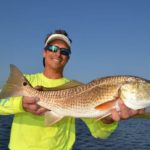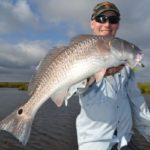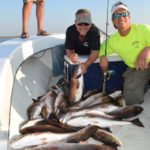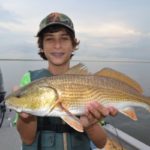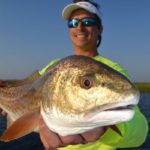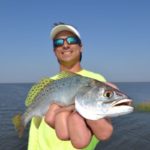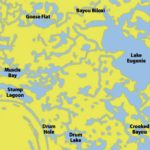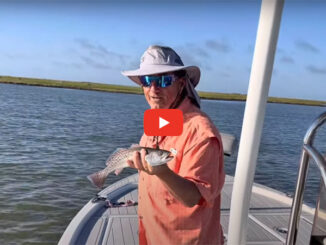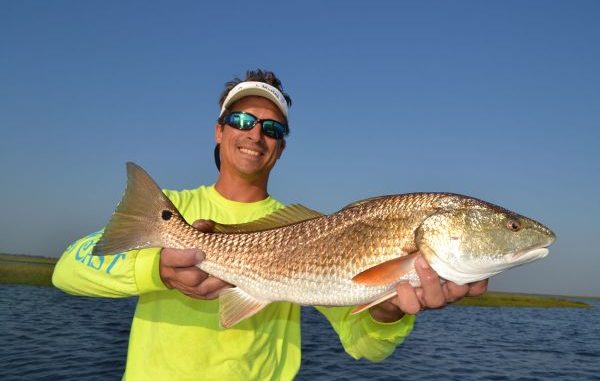
Redfish action in the Biloxi Marsh is so good this time of year, why would you ever make it your plan B?
Because the seasons in the Southern Hemisphere are the exact opposite of ours here in the Northern Hemisphere, their hurricanes occur when our tropics are as calm as a bottle of Valium.
So on April 10, 1996, a time when the only people in North America looking at weather maps of the Caribbean were those planning their summer vacations, the town of Barrow Island, Australia, was being pounded by Tropical Cyclone Olivia.
Such a sweet name, isn’t it?
Quite unfortunately, however, Olivia was anything but. She was a wicked, evil monster that made our favorite villain, Hurricane Katrina, seem like a wittle puddy tat.
On that day, on Barrow Island, was recorded the fastest wind speed ever seen on planet Earth – 253 mph. That’s enough wind to sweep even Rosie O’Donnell off her feet.
That wasn’t the kind of wind Capt. Mark Munson (504-234-0775) was dealing with last June, but still in all, it was more than enough to keep him and the rest of the Shell Beach angling fleet out of Lake Borgne, Bay Eloi and Lake Fortuna.
Every morning, every afternoon, every evening and every night, the wind blew. It wasn’t one of those crazy winds that follows a winter cold front and strips the trees of their few remaining leaves and rattles wood fences. It was more like God had turned on a non-oscillating fan – just constant, steady easterly winds in the 12- to 15-mph range.
The wind was bad enough, but the fact that it was in June compounded the misery. June is normally the first month of consistently calm winds. Kids are out of school, the air is warm but not yet miserably stifling and the trout act like they’ve just had their stomachs unstapled.
To make matters worse, last May was flat calm, and trout anglers loaded ice chest after ice chest after ice chest everywhere from Sabine Lake to the tip of Isle au Pitre. Nature gave them hours and hours of great fishing before she blew the door shut in June.
Anglers at many other ports sat home and cursed cruel fate, but Munson didn’t cancel a charter. He didn’t need to because of an extensive tract of untainted public wetlands in eastern St. Bernard Parish called the Biloxi Marsh.
More than 35,000 acres of the marsh are managed by the Louisiana Department of Wildlife & Fisheries as Biloxi WMA, so it’s free of the trespassing squabbles that plague so many other popular redfishing areas.
In speckled trout-crazy South Louisiana, it’s a great back-up spot for days when conditions prevent a trip outside. But really the action is so ridiculously good, it ought to be the primary plan for any fishing day.
“The redfishing has been off the charts,” Munson said while pulling away from Campo’s Marina last June. In his baitwell, enjoying a warm Jacuzzi bath, were 400 live shrimp seined from the marina’s tanks.
When he turned his 25-foot Privateer into the Mississippi River-Gulf Outlet, the east wind made its presence known and whispered into the ear of every angler on board that there would be no outside fishing on this day.
Munson knew as much, but he wasn’t disappointed.
“With that hard east wind pushing the water in, all the little baitfish are coming out of the ponds and trenasses,” he said. “We’ve just been hammering the redfish. Solid limits of nice slot reds — 16 to 27 inches. Pretty fish.
“The water clarity back there is exceptional. The marsh is just so protected. You get that deep, almost tannic-looking water like you would expect in parts of Hopedale and Delacroix in the winter, and those redfish get that deep, deep golden hue to them.
“They’re really beautiful fish right now.”
Munson made the run down the MRGO, turned into Bayou LaLoutre, ran carefully across Stump Lagoon and settled into Muscle Bay. No big secret: Muscle Bay is an annual hotspot that every local angler knows about.
He stopped at a point that looked promising, but three or four casts from each of the four anglers on board resulted in only one red, so Munson yanked up his Cajun anchor, and motored slowly along a shoreline on the western side of Muscle. He saw some finger mullet along the nondescript shoreline over a spot he knew held oyster shells. The water was beautiful, with at least 2 feet of visibility, and it had pushed way past the edge of the spartina.
Munson anchored within casting distance, and the first cast from Capt. C.T. Williams, who was along on the trip to film a spot for Fox 8 news in New Orleans, resulted in a takedown within milli-seconds.
Williams set the hook, and started talking to the camera.
Robert Campo, fishing from the back of the boat, followed quickly with a cast, and his cork immediately plunged in the direction of the core of the earth.
Hook set. Fish on.
Munson was torn between being a net man and joining the fun, so he did both. He cast a live shrimp under a cork, set the hook almost instantly, and used his free hand to net Williams’ fish.
The anglers were all grizzled fishing veterans, but over the next hour, there was no way to hide the fun they were having. It wasn’t manufactured for the TV camera. It was genuine, and it was filled with good-natured ribbing over bad hook sets and slow retrieves.
Campo swore every fish was the result of the quality of live shrimp from his marina, while Munson said it was only because of his exceptional guiding skills. Williams whistled the Jeopardy theme song while Campo fought a precocious red whose spunk belied its size.
Laughs and hoots were unstoppable. The anglers couldn’t have stifled them if they’d tried. There’s just something about a hot bite that brings out the kid in every angler. If that weren’t true, we’d probably take up a different sport — like golf.
The same east wind that trout anglers had been cursing was the one that played a major role in the ridiculously fast redfish action, Munson said.
“The ponds fill up — all this landlocked stuff — and it sets the bait free,” he said. “The reds are hitting the storm minnows and the finger mullet that came out of the ponds. They’re on the shorelines right now of the larger bodies of water, and not up in the ponds where you’d typically go looking for redfish.”
It’s not unusual for this time of year. When winds are brisk in June, they’re typically out of the east or southeast, and that does nothing but good things for the redfish action in the Biloxi Marsh. Winds from that direction blow in salty water from Breton Sound, and along with the water come gobs of baitfish. Redfish go on crazy days-long feeding binges during which they add size and weight very rapidly.
Campo loves the area, particularly this time of year, because it gives him a place to point small-boaters who show up at his marina. He knows that even inexperienced anglers will catch at least a few fish.
“We are 14 miles as the crow flies from Campo’s Marina,” he said while reeling in another Muscle Bay redfish. “It’s all inside waters; anybody can do it.
“You could come out here in a doggone kayak if you could paddle this far.”
Within mere minutes, the group reached their redfish limits, and decided to leave them biting. The day was still far too young to turn around and head back to the dock, so Munson suggested a try for trout in Lake Eugenie.
He knew the fish wouldn’t be the size of the ones in Breton Sound being protected by the wind, but he still thought he could find enough to make it worth his while.
He motored a short distance through the aptly named Crooked Bayou and into Lake Eugenie. The white caps in the lake made the anglers grateful they weren’t out in nearby Lake Borgne or Breton Sound.
Munson crossed to the east side of the lake, and began scanning for anything that looked promising. He found a huge school of bait-sized pogies on a point near Muscle Pass, and made a wide swing to motor his boat upwind.
When he was within casting distance of the point and the bait, he anchored up, and watched his charges for the day cast live shrimp into the terrorized pogies. Right away, the action was fantastic, with corks sinking and hooks repeatedly set.
Gill-rattling specks came over the bow one after another.
The fish were the size everyone likes to see on the plate rather than in the ice chest, but at least 50 percent were keepers — and with the frenzied pace of the bite, it wouldn’t take the anglers long to reach their limits.
Quite remarkable considering the conditions, but Munson wasn’t surprised at all.
“This is a lot closer to where we’ve been fishing, the very edge of the Biloxi Marsh before it goes out into the sound,” he said. “You still have a little bit of protection here, so the water clarity is better than it’s going to be out toward the edge, toward Lake Borgne and Breton Sound.
“You see all the baitfish on the water — all the pogies and stuff that got pushed in with this high water. The trout are in here feeding on them.”
The area featured the “big three” of what Munson looks for to get on a hot bite.
“You’ve got clean water, moving water and bait — that’s the key combination,” he said. “You’re close to where you should be fishing this time of year, if we didn’t have all these winds.
“The fish will follow the bait in with all this water.”
Munson found the specks near Muscle Pass, which is a conduit for water to move in and out of the marsh.
“They’ve got bait all up in here. The water is coming from the outside right there, and that’s the edge of the marsh, the tip of the sound,” Munson said while pointing with his head over his shoulder. “You’ve got moving water on this point, and then this little pass right here.
“When we saw the bait on this particular point, that made it kind of a no-brainer.”
We had an ice chest bursting at the seams with limits of redfish and speckled trout, and this was the back-up plan.
How can you not love Louisiana?
